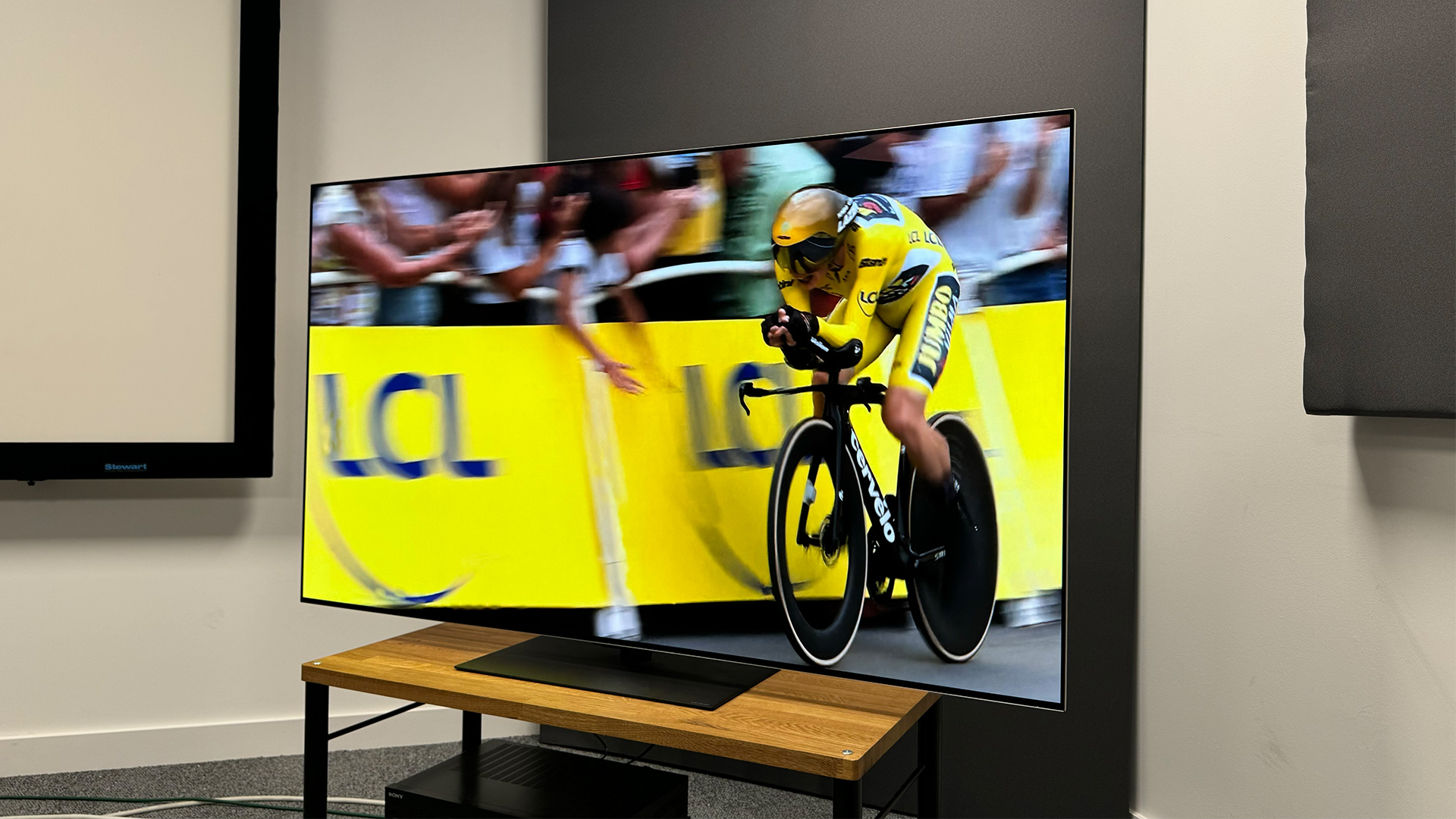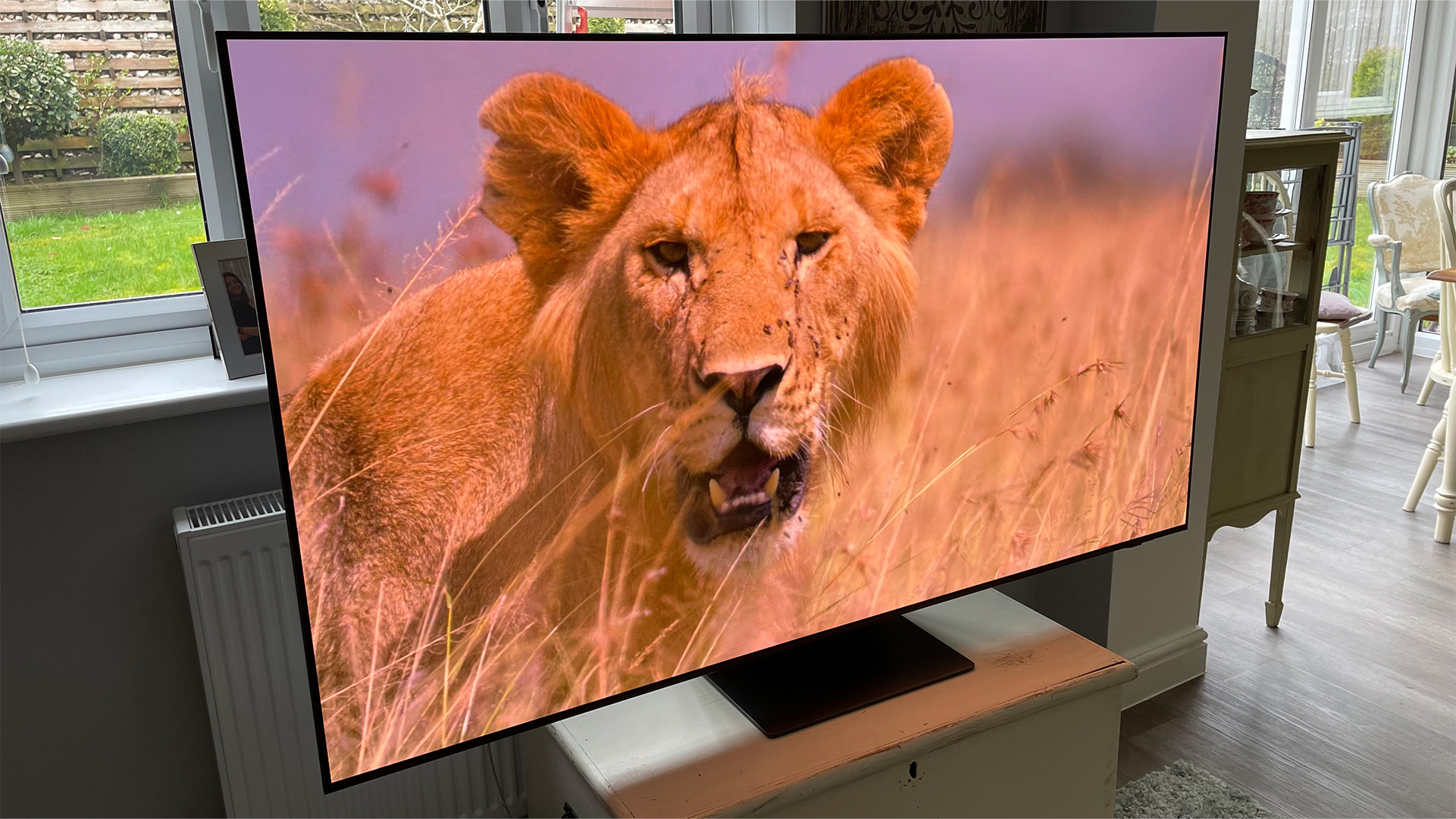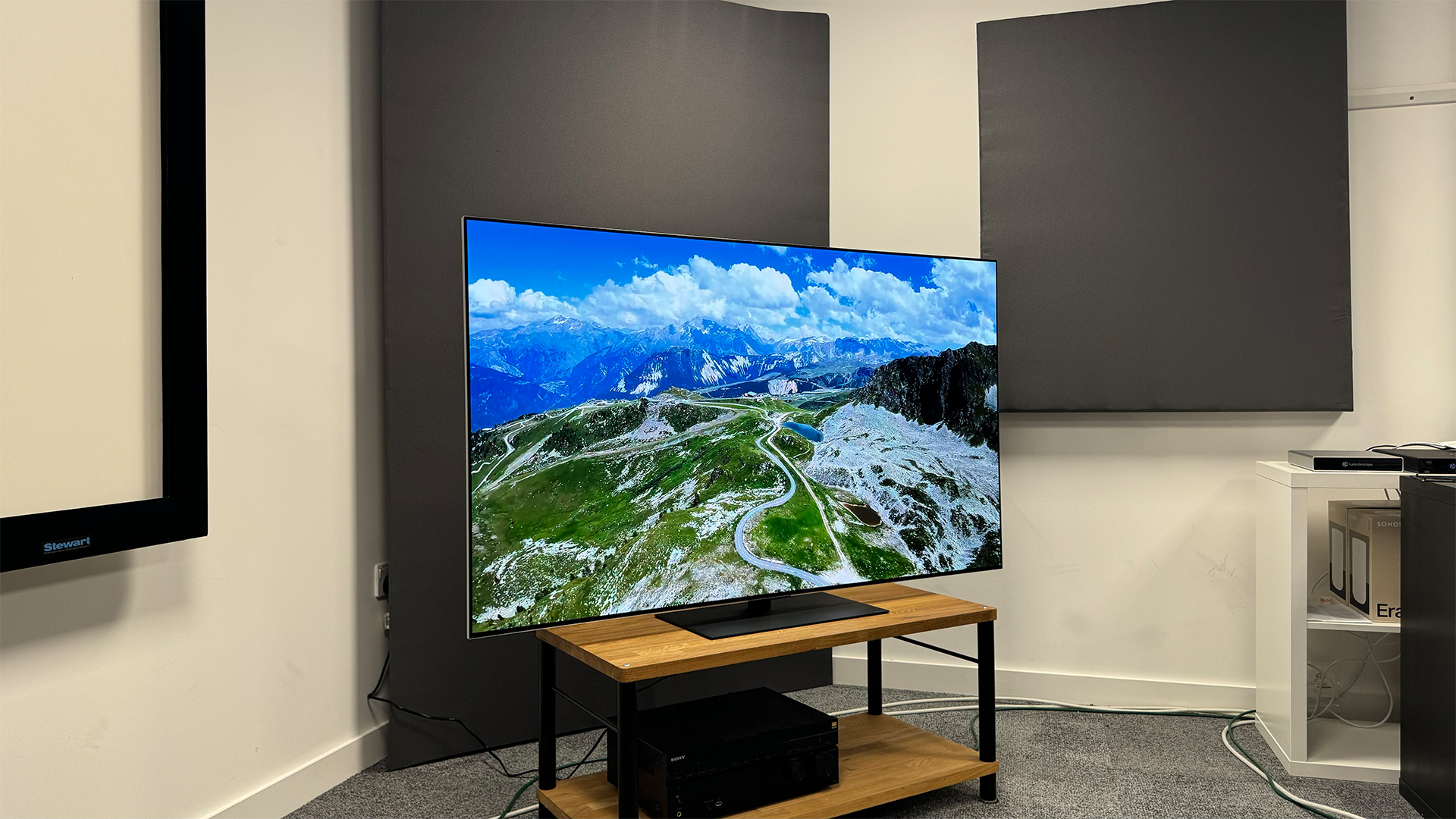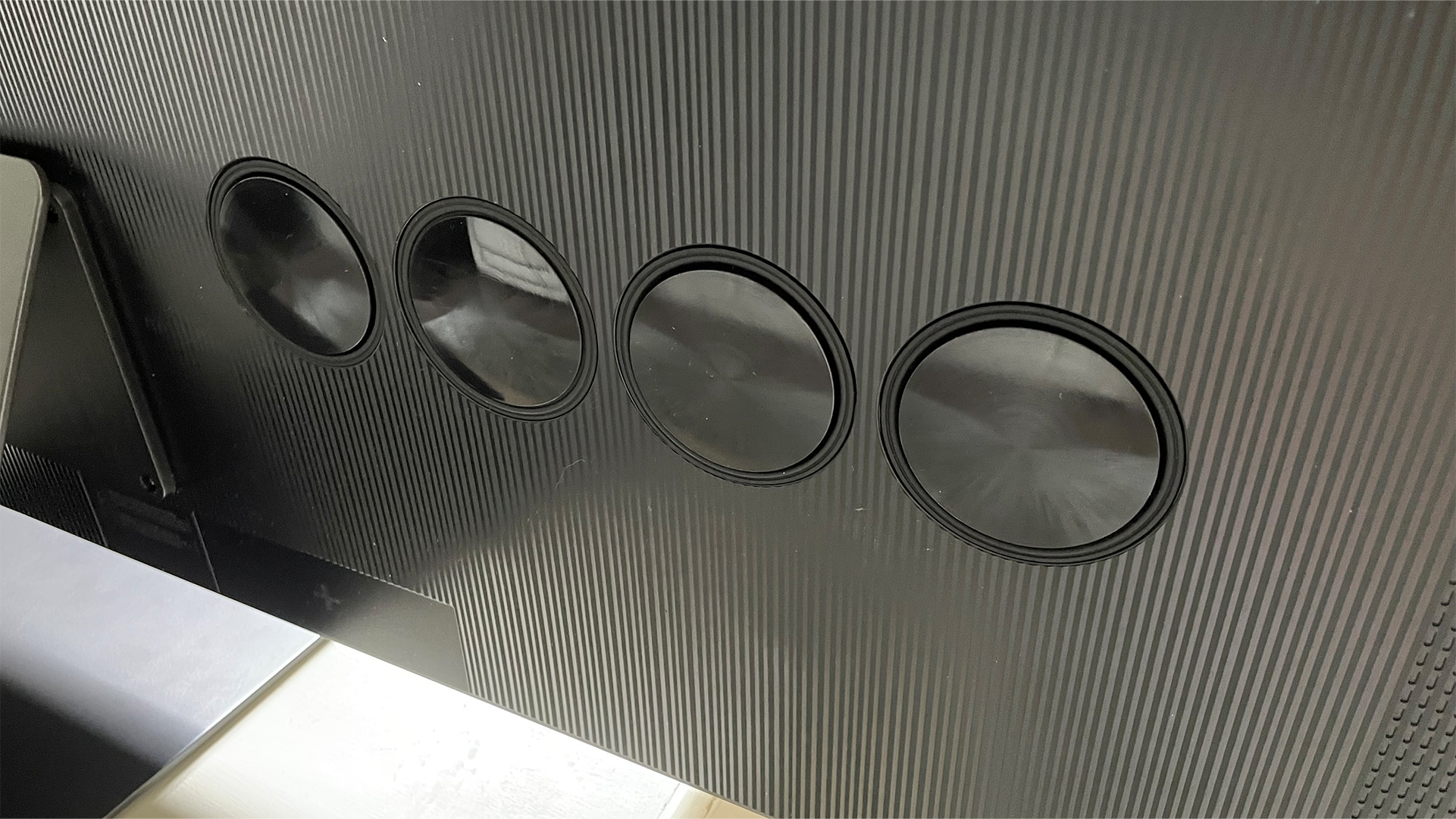LG G4 vs Samsung S95D: which 2024 flagship OLED TV is better?
A serious OLED showdown

Screen size: 65in (also available in 55in, 77in, 83in and 97in)
HDR formats: HLG, HDR10, Dolby Vision
HDMI inputs: x4 (4 x 48Gbps HDMI 2.1)
Dimensions (hwd, without stand): 145 x 84 x 5.7cm
The G4 is a big improvement on the G3, with stellar HDR, great colour accuracy across the spectrum and superb motion handling. Like previous LG OLEDs, it's fantastic for gamers, too. But while the sound is a step up on its predecessor, it's still not brilliant, but then the S95D doesn't escape unscathed either.
Pros
- Brilliantly bright picture that’s full of contrast
- Stellar gaming features
- Accurate motion handling
Cons
- Thin audio that’s prone to sibilance

Screen size: 65in (also available in 55in, 77in)
HDR formats: HLG, HDR10, HDR10+
HDMI inputs: x 4 (4 x 48Gbps HDMI 2.1)
Dimensions (hwd, without stand): 83 x 144 x 1cm
The S95D landed first and set the bar very high indeed. It excels in terms of brightness, colour and contrast, with a more nuanced approach than previous Samsungs. The anti-reflective filter will be a boon to anyone hoping to enjoy the summer of sport, and it's very well-equipped for gamers, too. It manages wider colour hue than the G4, though not as bright peak whites. A great TV, but we prefer the G4's visuals.
Pros
- Phenomenal brightness, contrast and colour
- Excellent gaming support
- Anti-reflection filter works almost uncannily well
Cons
- Filter has minor negative side effects
- Audio lacks power and impact
- Some minor shadow detail loss
LG and Samsung's latest flagship TVs are now on sale. The G4 and S95D are two of the most exciting TVs we'll see this year, and now we've reviewed both, we can advise on which is right for you.
The S95D features a third-generation QD-OLED screen panel which is Samsung's brightest yet. It also has a higher refresh rate than last year's S95C, and a proprietary picture quality engine.
But LG has reasons to feel confident. With a new processor, MLA tech and new features, the G4 has put some real distance between it and the step-down C4.
With different operating systems and prices, picking one won't be easy. Let's see which you should buy.
- LG G4 vs C4: what's the difference?
- LG G4 vs Samsung S95D: what are the differences?
LG G4 vs Samsung S95D: price
There's really not much to choose between these two when it comes to price. The S95D's launch price is a little higher in the UK, but a little cheaper at some sizes in Australia. In the US, the two are even.
The G4 does come in an 83-inch model, which the S95D doesn't. And remember: these two brands are often heavily discounted come sale time, so keep a look out if Amazon Prime Day happens this year. The S95D has already dropped by a few hundred pounds at Samsung itself, so you can bet there will be plenty of deals around.
Check out the full price comparison (complete with last year's models) in the table below.
The latest hi-fi, home cinema and tech news, reviews, buying advice and deals, direct to your inbox.
** Winner: LG G4 **
| Size | LG G3 | Samsung S95C | LG G4 | Samsung S95D |
|---|---|---|---|---|
| 55 inches | £2600 / $2500 / AU$4195 | £2699 / $2499 / AU$3999 | £2400 / $2599 / AU$4199 | £2499 / $2599 / AU$3999 |
| 65 inches | £3500 / $3300 / AU$5295 | £3599 / $3299 / AU$4999 | £3300 / $3399 / AU$5299 | £3599 / $3399 / AU$4999 |
| 77 inches | £5000 / $4500 / AU$8395 | £5099 / $4499 / AU$7999 | £4500 / $4599 / AU$7999 | £4599 / $4599 / AU$7999 |
| 83 inches | £7500 / $6500 / AU$10,995 | N/A | £7000 / $6499 / AU$9999 | N/A |
LG G4 vs Samsung S95D: design

The G4 might not look like much of a change from the G3, but there is one rather large improvement: a stand. The G3 was designed purely for wall-mounting, but LG now bundles a pedestal stand with the 55- and 65-inch versions of G4. The larger models come with the Zero Gap Wall Mount – a bracket designed to sit the TV flush against your wall. The stand is a bit wobbly (especially on the higher setting to leave space for a soundbar), but it still gives the smaller models much more mainstream appeal.
A word of warning: make sure you order the correct model, as you have to specify whether you want a stand or wall mount when you buy the TV. The stand models have an 'S' at the end (OLED65G46LS), while the wall mounts have a 'W' (OLED65G45LW).
Other than that, it's business as usual on the design front. The G4 has a picture frame-like design with a step around the edges. Its thickness is between 2.4cm and 2.8cm, depending on which size you buy.
The S95D has the ultra-slim bezel we would expect from Samsung. Last year's S95C had a uniform thickness of 1.1cm, making it nice and slim without feeling flimsy. It also made it perfect for wall-mounting without an unsightly gap between it and the wall.
This year's model has cut that down to an even 1cm. In our review, we described it as "one of the slimmest, most lip-lickingly wall-hangable TVs there has ever been. A slinky monolith that has no right to be capable of delivering the powerhouse pictures we’re going to be describing later."
Like its predecessor, the S95D features the One Connect Box – a separate box that houses all the connections like power and HDMI. This then runs with a single thin cable to the TV itself, giving the set a pleasingly minimalist look.
The S95D also ships with a stand, though a TV this slim really belongs on the wall – otherwise it feels a bit fragile.
** Winner: Samsung S95D **
LG G4 vs Samsung S95D: features

Both of these TVs are premium models, and are suitably feature-packed.
For the first time, the 83-inch version of the G4 boasts the second-gen MLA OLED panel (last year's 83-inch G3 had a standard OLED panel lacking MLA). This can go 50 per cent brighter than the previous version, which makes the G4 stunningly bright.
This brightness is in full effect using the G4's Peak Highlighter feature. This ups the brightness of small highlights (up to 3 per cent of the screen) by up to 150 per cent of the brightness of which LG's standard OLED screens are capable.
Inside, the Alpha 11 AI Processor enables Peak Highlighter, as well as AI Director Processing, which tweaks the picture to best match the director's intended colour tone, and Object Enhancing by Visual Perception, which enhances each pixel. AI Sound Pro, meanwhile, ups the virtual surround sound to 11.1.2 channels.
The refresh rate has been increased to 144Hz (up from 120Hz on the G3) – PC gamers will see the benefit, but consoles max out at 4K 120Hz, which is still supported. ALLM and VRR are also available for gamers, while there are four HDMI 2.1 ports to take a soundbar (via eARC) and up to three consoles/gaming PCs at once.
The webOS 24 operating system has some neat updates. Recommendations come back to the home page, while Quick Cards are now smaller and dynamic. It supports up to 10 user profiles, with bespoke recommendations for each, and soon it'll be able to recognise who's talking and tailor its responses to them. You also get free updates for at least five years.
The S95D has a proprietary picture quality engine and the same 144Hz refresh rate as the G4. It has the same VRR, ALLM and HGiG gaming features, and four HDMI 2.1 ports alongside the HLG, HDR10, HDR10+ formats of HDR. It also has an HDR game mode that reduces input lag to just 9.8ms.
It upscales sub-4K content better thanks to its new processor, while the Real Depth Enhancer manipulates image to create a more three-dimensional and lifelike look. A new OLED HDR Pro system delivers more accurate colour mapping with a little help from the experts at Pantone, and the latest version of Samsung’s Object Tracking Sound+ system now works with Dolby Atmos sound mixes too.
It's the third generation of TV with Samsung's QD-OLED tech. This shines a blue organic light through red and green Quantum Dot layers to produce ‘pure’ RGB colour reproduction without the additional brightness-boosting white element used by standard WRGB OLED (often referred to as ‘WOLED’) screens. And it's substantially brighter than the (already very bright) S95C.
New for 2024 is Samsung's 'OLED Glare Free' tech. It uses a low-reflection coating which claims to "preserve colour accuracy and reduces reflections while maintaining image sharpness to ensure an immersive viewing experience, even in daylight". Ideal for watching sports like the Olympics in the middle of the day in the height of summer. And it neutralises reflections without the dreaded rainbow effect that we've seen from lesser systems.
Samsung's Tizen OS has been given a refresh, and now has a profile system so everyone in the household can manage their own viewing. A new For You content accumulator recommends content based on your viewing habits from all available sources.
** Winner: LG G4 **
LG G4 vs Samsung S95D: picture

In terms of picture quality, the G4 is a step up on the G3 in pretty much every way. But you will need to fiddle with the settings to get the best out of it.
That's because out of the box, the AI-powered picture processing is a bit much. But some of the features are best left on, like Cinematic Movement, which inserts frames into the picture to make it look smoother during frantic scenes. It's much more effective and natural-looking than the S95D's attempts, which introduce artefacts as the TV guesses what should be inserted.
The G4's MLA panel comes into its own with bright lights in a dark scene, adding heaps of contrast. The TV also fixes one of the G3's biggest problems – a lack of vibrancy in low light scenes. While the G3 looked a bit pale and dull, the G4 has much more robust colour reproduction, especially when it comes to skin tones. This is another point in the G4's favour over the S95D, which makes skin look a little cool compared to the warmth of the G4.
The G4's picture holds brilliant brightness, but its peaks are something else. It's not just stunning the way a shop demo is, it makes for a much more detailed picture, really enhancing your viewing.
The S95D does manage a slightly wider range of colours, though this is only noticeable with very bright HDR content. Talking of bright, the S95D more than holds its own against the G4 in this regard. Aggressively mastered movies really show off what it can do: witness Pan, or Mad Max: Fury Road to see real intensity in the bright highlights and richly saturated colours. Of course, its blacks are as inky as we would expect from an OLED TV.
The S95D's upscaling is on point, with the eagle-eyed AI spotting the difference between natural grain and mastering noise in HD sources of all provenances. Which makes for a wonderfully cinematic feel that's clean without being overly sanitised.
When ultra-bright bright HDR content fills the screen (and not just parts of it), it isn't quite as bright as a rival LCD TV, however. There's a touch of blooming around bright objects caused by the anti-reflection filter, occasional jumps in the brightness levels in Standard mode, and some loss of shadow detail in dark areas. But these faults are very minor considering everything the S95D gets right.
The contrast is better than any TV we've ever tested, in both Movie mode and the punchier Standard mode. Samsung has always produced bright TVs, but whereas previous models have looked a bit sherbert-y and artificial, the S95D is more organic and natural. Just avoid the over-eager Dynamic preset.
A lot of this is thanks to the anti-glare filter, which really allows you to connect with the image in a bright room. It's a testament to Samsung's engineers focussing on how people actually watch TV, and not how they would like them to.
On a pure picture level, there's less clipping than with the S95C, making for a more consistently detailed, three-dimensional performance. And thanks to the fine mapping of colour tones across a wider colour volume, the picture looks sharper and crisper than its predecessor's.
** Winner: LG G4 **
- WOLED vs Quantum Dot OLED: what are the differences and which is better?
LG G4 vs Samsung S95D: sound

LG doesn't have a good track record in the TV sound department. The G3 sounded pretty poor, especially for such a premium TV. This year's model fares much better, but as is written on so many school reports, there's room for improvement.
Again, to get the best out of it you'll have to jump into the menus. The Standard setting is flat, thin and thoroughly uninspiring – it's fine for watching casual TV like the news or a sitcom, but not much else. Fire up AI Sound Pro and you'll immediately hear the benefit.
Dialogue is more direct and distinct from the background sound. Bass is more precise and controlled than on the G3, though overall the audio still lacks a bit of impact – it could be a lot more dynamic, while sibilance creeps in at higher frequencies. Still, it's a big improvement on the G3, so LG is moving in the right direction.
The Samsung S95D's object-tracking sound system creates a soundstage that extends beyond the confines of the screen, and is able to place sounds very accurately. The audio is clean, and details distinct. But it's not nearly forthright enough – it seems to happen in front of you, instead of enveloping you in the action. And even at maximum volume, it's not nearly loud enough, with a limited dynamic range and underwhelming bass. At least there's no crackle and distortion.
** Winner: Draw **
LG G4 vs Samsung S95D: verdict
With very similar prices and lots of improvements over last year's models, this is a really close one.
The S95D is the more eye catching of the two, largely thanks to its razor-thin design and One Connect box hiding all the unsightly connections. But for our money, the G4 has the better picture, blending stunningly bright highlights with more natural skin tones for a thoroughly engaging viewing experience. Both TVs are equally underwhelming in terms of sound, but that's no great surprise – as ever, we recommend you buy a soundbar to make the audio as impressive as the visuals.
Whichever TV you choose, you'll be well served. And with summer sales season just around the corner, both TVs should see some decent discounts.
MORE:
Read our Samsung S95D review
And our LG G4 review
Our pick of the best TVs you can buy right now
Joe has been writing about tech for 20 years, first on staff at T3 magazine, then in a freelance capacity for Stuff, The Sunday Times Travel Magazine (now defunct), Men's Health, GQ, The Mirror, Trusted Reviews, TechRadar and many more. His specialities include all things mobile, headphones and speakers that he can't justifying spending money on.

